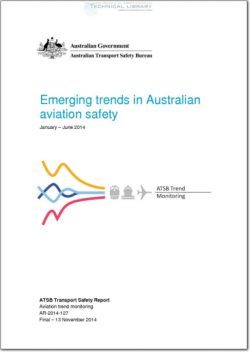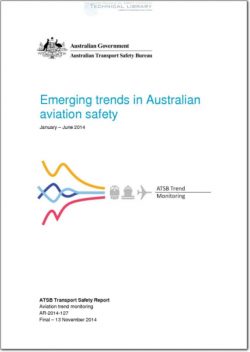ATSB-AR-2014-124

- Version
- 193 Downloads
- 622.43 KB File Size
- 1 File Count
- August 9, 2016 Create Date
- August 9, 2016 Last Updated
Emerging Trends in Australian Aviation Safety - January to June 2014

When aviation safety incidents and accidents happen, they are reported to the ATSB. The most
serious of these are investigated, but most reports are used to help the ATSB build a picture of
how prevalent certain types of occurrences are in different types of aviation operations.
The ATSB uses this data to proactively look for emerging
safety trends. By monitoring trends, issues of concern can be
communicated and action taken to prevent accidents.
Proactive trend monitoring is a data-driven process, reviewing
all occurrences to see if there are subtle changes that may
point to a larger issue. Potential issues are then monitored by gee
the ATSB, and shared with industry and other government :3
agencies. Safety actions can then be taken by the most gm
appropriate people to prevent these issues resulting in
accidents. These trends can also point to the need for the
ATSB to target particular types of occurrences for
investigation.
This report summarises significant trends in Australian
aviation from January to June 2014, and resultant safety
action being taken to address these trends.
ATSB trend monitoring reviews the rate of reported aviation occurrences (per 100,000 departures
or hours flown) biennially, and compares it to the 5 year average. The ATSB performs this
assessment independently for every type of occurrence involving high capacity regular public
transport (RPT) and charter, low capacity RPT and charter, general aviation, and recreational
aviation.
Further analysis can show what aircraft models, operators, or locations account for most of the
difference, and whether this has been a long term trend orjust a spike. When a single operator
accounts for most of the difference, the ATSB contacts them for information and comment.
Sometimes increases are solely due to a good reporting culture, sometimes because of changes
to operations, aircraft, or regulations, and sometimes there is no apparent explanation.
In almost all cases, a significantly different occurrence rate to normal is due to something
explainable, and something that does not pose an imminent risk to the safety of aircraft operators,
passengers, or the public.
| File | Action |
|---|---|
| ATSB-AR-2014-124 Emerging Trends in Australian Aviation Safety - January to June 2014.pdf | Download |

Comment On This Post